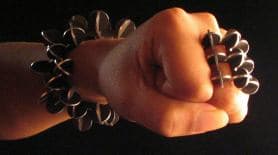
-----
Chromic acid treatment on Magnesium jewelry
I'm making on a small scale milled jewelry, and because of tool costs a start using magnesium as a testing material, but now people like those tests more then the "real" result!
So I give the Magnesium a surface treatment to protect it from corroding.
I use a warm chrome acid pickle layer and know about the cancer risk off this liquid, but does the resulting layer also provoke cancer?
Thus anybody knows?
Of course I should love to have another way but as far as I know none of the existing techniques are easy and economical for the single pieces like I make.

finesmith - Wilhelminaoord, Drenthe, Netherland
April 9, 2009
It is quite easy to anodise magnesium - and a great deal safer.

Geoff Smith
Hampshire, England
April 11, 2009
April 12, 2009
Try next green anodizing formula: NaOH..........300 gr
sodium silicate....35 mll
phenol........3,5 gr
water.......1 lit
85 C,4-6 V,10-40 A/sq.ft,
5-25 min
According to Fishlock:Metal Colouring,Teddington 1962.
Hope it helps and good luck!
- Cerovski vrh Croatia
April 14, 2009
Geoff & specially Goran,
Thanks for the responds, I'm going to try immediate, but in the mean time I still waiting for a answer on my question!
I will report the results.
- Wilhelminaoord, Holland
If you are not depositing anything on the surface during your cleaning process you will be OK. If there is residual chromic acid or if you have produced a chromated surface to the magnesium then there are potential issues with the product. Hexavalent chromium compounds are severe skin irritants and sensitising. Chromic acid is known to cause chrome ulcers, which take forever and a day to heal. Most hexavalent compounds are only classified as carcinogenic by inhalation, so just wearing the products will not cause cancer, but if you carry out and form of abrasion and create a dust that is respirable you leave yourself open to the possibility of cancer.
Hexavalent chromium compounds in professionals hands is bad enough, in the hands of an amateur it is potentially lethal.
Aerospace - Yeovil, Somerset, UK
April 15, 2009
Thanks, Brian. I think the health authorities create a bit of a semantic problem when they use the verb "cause" as a synonym for the phrase "increase the likelihood of contracting" .
Which is to say that jewelry should never receive a hexavalent chromium treatment even if wearing it has not yet been proven to "cause" cancer; but Leo has not necessarily already condemned himself to cancer by polishing this stuff, even if he has inhaled a bit of the dust.
Regards,

Ted Mooney, P.E.
Striving to live Aloha
finishing.com - Pine Beach, New Jersey
Ted is available for instant help
or longer-term assistance.
April 15, 2009
April 16, 2009
Ted,
I agree that the semantics of health & safety sometime hide the true hazards. But in the end, why take the risk?
I agree it may never affect Leo, yet if he is one of the susceptible individuals then any exposure may well trigger one of the conditions associated with hexavalent chromium.
The simple thing is there are very easy and inexpensive ways of avoiding exposure such as wet abrading and the use of a simple dust mask.
Aerospace - Yeovil, Somerset, UK
It took a while, first before the few chemicals that I needed to came, 3 weeks!
But apart of a slight green on a corner, I have not had much success.
So I wonder the following modifications:
Do I have the chemicals mixed in a special way?
The work must be on the plus,
Do I need an acid dip before the anodisation?
- Wilhelminaoord Drenthe Netherland
May 18, 2009
That is just one formula from Fishlock's book, without any special details on pretreatment.Obtained oxide layer can be dyed. According to another book (-Nichtmetallische Anorganische Ueberzuege by W.Machu) that process includes alkaline degreasing, chromic acid pickling and after treatment with chromic acid. So try to dye it with some black dye (or any other color) hope it helps and good luck
Goran Budija- Cerovski vrh Croatia
May 21, 2009
Q, A, or Comment on THIS thread -or- Start a NEW Thread
